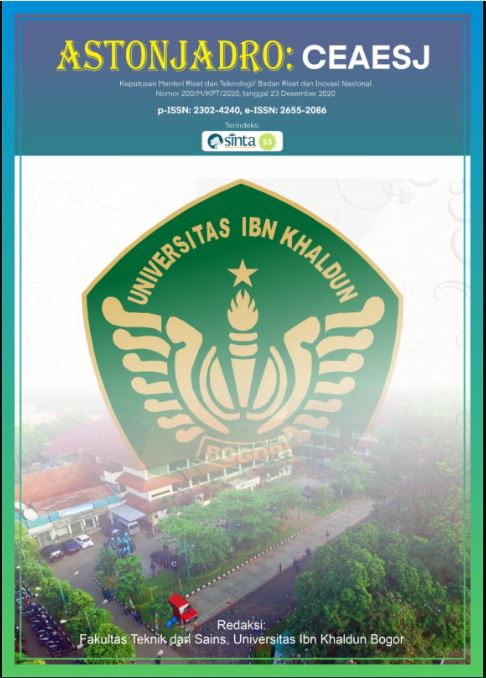DELAY ANALYSIS USING IN-DEPTH INTERVIEW METHOD: CASE STUDY POST-DISASTER RECONSTRUCTION IN LOMBOK
DOI:
https://doi.org/10.32832/astonjadro.v11i2.6702Keywords:
delay, post-disaster, reconstruction, Lombok, facilitators.Abstract
Earthquake disasters have a significant impact, especially on infrastructure, socio-economy, and housing. In August 2018, there were earthquakes in Lombok; the Government then issued a reconstruction policy, especially in the housing sector. In the worst affected areas in North Lombok, the reconstruction process is targeted to be completed in March 2019, but as of February 2020, at least 7,210 houses have not been constructed. Further discussion is needed to determine the delay factors in post-disaster housing reconstruction. A qualitative approach was chosen to emphasize the benefits and information gathering by exploring the phenomenon under study. Seven informants from representatives of the Government, facilitators, and the community were selected to be interviewed regarding the delays. The data analysis used in this study used a descriptive approach by categorizing the results of the interviews according to previous research and experts. Thus, data analysis was found five issues of delay that are closely related to communication and coordination, human resources, materials and supplies, workmanship and quality, and monitoring.
References
Azhari, M. F., Rasimeng, S., & Mulyanto, B. S. (2020). Analisis Deformasi Permukaan Menggunakan Metode Dinsar ( Differential Interferometry Synthetic Aperture Radar ) Pada Studi Kasus Gempabumi Lombok Periode Agustus 2018 Analysis Of Surface Deformation Using Dinsar Method ( Differential Interferometry Synthe. Vol. 06 (02). pp. 131–144.
Bilau, A. A., Witt, E., & Lill, I. (2018). Practice framework for the management of post-disaster housing reconstruction programs. Sustainability (Switzerland), 10(11), 18–20. https://doi.org/10.3390/su10113929
Bird, P. (2003). An updated digital model of plate boundaries. Geochemistry, Geophysics, Geosystems, 4(3). https://doi.org/10.1029/2001GC000252.
BNPB. (2020). Data Informasi Bencana Indonesia. Retrieved from http://bnpb.cloud/dibi/xdibi_list?vth=2019&vbl=&vtg=&vjn=108&vpr=&vkb=&jflag=2&start=10#].
Bowles, W., & Alston, M. (1998). Research for Social Workers: An Introduction to Methods. Australia: Allen &Unwin.
Dumadi, T. A., Sunarjono, S., & Sahid, M. N. (2014). Evaluasi Pelaksanaan Proyek Menggunakan MetodeEarned Value Analysis. Simposium Nasional RAPI XIII-2014 FT UMS, 36–42. (Indonesian).
Elsen, R., Cahyana, R., & Satria, E. (2019). Disaster management system on the mobile environment. Journal of Physics: Conference Series. 1402(7). https://doi.org/10.1088/1742-6596/1402/7/077018.
Grinell, R. M. (1993). Social Work Research and Evaluation. Itasca: F.E. Publisher
Istikomah, M. ., Sunardi, B., & Marzuki, M. S. (2019). Indonesian Physical Review. 2(1), 1–8.
M. Islam, S. Widiyantoro, D. H. Natawidjaja, I. Milano, A. Rudyanto, S. Hidayati, W. Triyoso, N. R. Hanifa, D. Djarwadi, L. Faizal, Sunarjito, Source and Hazard Map of Indonesia Earthquake 2017, 1, 400 (Center for Housing and Settlement Research and Development, Research and Development Agency, Ministry of Public Works and Housing, Bandung, 2017).
Moleong, L. J. (2004). Metode Penelitian Kualitatif. Bandung: PT Remaja Rosdakarya. (Indonesian).
Nugraha, P. (2019). Govt provides 40,000 houses to victims of Lombok earthquake - National - The Jakarta Post. The Jakarta Post. Retrieved from https://www.thejakartapost.com/news/2019/10/12/govt-provides-40000-houses-to-victims-of-lombok-earthquake.html
Purworini, D., Purnamasari, D., & Puji Hartuti, D. (2019). Crisis Communication in a Natural Disaster: A Chaos Theory Approach. Jurnal Komunikasi: Malaysian Journal of Communication, 35(2), 35–48. https://doi.org/10.17576/JKMJC-2019-3502-03
Salam, B. Al. (2019). ANALISIS FAKTOR-FAKTOR PENYEBAB PEMBENGKAKAN BIAYA OLEH KONTRAKTOR PROYEK JALAN KOTA SOLO. Jurnal Litbang Sukowati : Media Penelitian Dan Pengembangan, 4(1), 13. (Indonesian). https://doi.org/10.32630/sukowati.v4i1.117
Saputra, C. R. (2020). Rehabilitation and reconstruction of community housing postWest Nusa Tenggara Earthquake 2018 (A case of Lauk Rurung Timuk and Lauk Rurung Barat Sub-villages, Sembalun Bumbung, Sembalun, East Lombok). E3S Web of Conferences, 156. https://doi.org/10.1051/e3sconf/202015605017
Smith G., Martin A., Wenger D.E. (2018). "Disaster Recovery in an Era of Climate Change: The Unrealized Promise of Institutional Resilience.” Handbook of Disaster Research. Springer, 595-619.
Yin, Robert K. (1984). Case Study Research Design & Methods. Beverly Hills: Sage Publication.
Zainal Arifin. (2014). Penelitian Pendidikan Metode dan Paradigma Baru: PT Remaja RosdaKaya, Bandung. (Indonesian).
Downloads
Published
How to Cite
Issue
Section
License
Paper submitted to ASTONJADRO is the sole property of the Astonjadro Journal. Unless the author withdraws the paper because he does not want to be published in this journal. The publication rights are in the journal Astonjadro.ASTONJADRO
LICENSE
This work is licensed under a Creative Commons Attribution-ShareAlike 4.0 International License.
Based on a work at http://ejournal.uika-bogor.ac.id/index.php/ASTONJADRO













